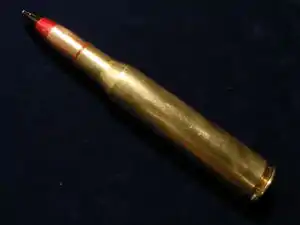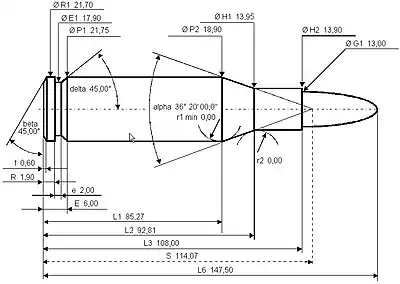12.7×108mm
The 12.7×108mm cartridge is a 12.7 mm heavy machine gun and anti-materiel rifle cartridge used by the former Soviet Union and Warsaw Pact countries, including Russia, China, Iran, North Korea, and many others. It was invented in 1934 to create a cartridge like the German 13.2mm TuF anti-tank rifle round and the American .50 Browning Machine Gun round (12.7×99mm NATO).
| 12.7×108mm | ||||||||||||||||||||||||
|---|---|---|---|---|---|---|---|---|---|---|---|---|---|---|---|---|---|---|---|---|---|---|---|---|
 A 12.7×108mm cartridge | ||||||||||||||||||||||||
| Type | Heavy machine gun Anti-materiel rifle | |||||||||||||||||||||||
| Place of origin | Soviet Union | |||||||||||||||||||||||
| Service history | ||||||||||||||||||||||||
| In service | 1935–present | |||||||||||||||||||||||
| Used by | Soviet Union and successor states | |||||||||||||||||||||||
| Wars | Winter War World War II Korean War Portuguese Colonial War Vietnam War Cambodian Civil War Cambodian–Vietnamese War Six-Day War War of Attrition The Troubles Yom Kippur War Soviet–Afghan War Iran–Iraq War Gulf War Chechen War Iraq War War in Afghanistan Libyan Civil War Syrian Civil War Nagorno-Karabakh conflict Russo-Ukrainian War | |||||||||||||||||||||||
| Specifications | ||||||||||||||||||||||||
| Case type | Rimless, bottleneck | |||||||||||||||||||||||
| Bullet diameter | 12.98 mm (0.511 in) | |||||||||||||||||||||||
| Neck diameter | 13.95 mm (0.549 in) | |||||||||||||||||||||||
| Shoulder diameter | 18.90 mm (0.744 in) | |||||||||||||||||||||||
| Base diameter | 21.75 mm (0.856 in) | |||||||||||||||||||||||
| Rim diameter | 21.70 mm (0.854 in) | |||||||||||||||||||||||
| Rim thickness | 1.90 mm (0.075 in) | |||||||||||||||||||||||
| Case length | 108 mm (4.3 in) | |||||||||||||||||||||||
| Overall length | 147.50 mm (5.807 in) | |||||||||||||||||||||||
| Case capacity | 22.72 cm3 (350.6 gr H2O) | |||||||||||||||||||||||
| Primer type | Berdan | |||||||||||||||||||||||
| Maximum pressure | 360 MPa (52,000 psi) | |||||||||||||||||||||||
| Ballistic performance | ||||||||||||||||||||||||
| ||||||||||||||||||||||||
| Test barrel length: 1000 mm | ||||||||||||||||||||||||
It is used in the same roles as the NATO .50 BMG (12.7×99mm NATO) cartridge. The two differ in bullet shape and weight, and the casing of the 12.7×108mm is slightly longer, and its larger case capacity allows it to hold slightly more of a different type of powder. The 12.7×108mm can be used to engage a wide variety of targets on the battlefield, and will destroy unarmored vehicles, penetrate lightly armored vehicles and damage external ancillary equipment (i.e.: searchlights, radar, transmitters, vision blocks, engine compartment covers) on heavily armored vehicles such as tanks.[1] It will also ignite gasoline and—since 2019—diesel fuel (experimental "Avers" AP/I round).[2][3]
Cartridge dimensions
The 12.7×108mm has 22.72 ml (350 grains) H2O cartridge case capacity.

12.7×108 maximum cartridge dimensions. All sizes in millimeters (mm).
Americans define the shoulder angle at alpha/2 ≈ 18.16 degrees.
According to guidelines the 12.7×108mm case can handle up to 360 MPa (52,213 psi) piezo pressure. In C.I.P. regulated countries every rifle cartridge combo has to be proofed at 125% of this maximum CIP pressure to certify for sale to consumers.
Cartridge types
Soviet and Russian 12.7×108 types
- Б-30 / B-30
- First version of 1930. Armor-piercing (бронебойная) bullet weighing 49 g (1.7 oz) and 64 mm (2.5 in) long with hardened steel core.[4] Replaced by B-32.
- БЗТ / BZT
- Pre-WW2 armor-piercing incendiary (зажигательно) tracer.[4] Replaced by BZT-44.
- Б-32 / B-32 (GRAU# 57-BZ-542, 7-BZ-2)
- Steel-cored API bullet. Main type in use.[4] Penetrates 20 mm (0.79 in) NATO medium-hard RHA from 500 m (1,600 ft) at 0° when fired out of DShKM. Penetrates 20 mm (0.79 in) 2P steel from 100 m (330 ft) at 0° when fired out of NSV-12.7. First produced 1936; named after the B-32 7.62×54mmR ammunition of 1932.
- БС-41 / BS-41
- API bullet weighing 55.4 g (1.95 oz) and 51 mm (2.0 in) long with a cemented carbide (Re8 WC-Co) core. Produced in small quantities at the beginning of WWII for the 12.7 mm Sholokhov anti-tank rifles (PTRSh-41).
- БЗТ-44 / BZT-44 (GRAU# 57-BZT-542)
- APIT with brighter tracer, usually used with B-32. Complemented by BZT-44M (GRAU# 57-BZT-542M) of 2002 with subdued tracer.
- БЗФ-46 / BZF-46
- API bullet with (white) phosphorus (фосфорная). Aircraft MG round.
- БС / BS (GRAU# 7-BZ-1)[5]
- API bullet with cemented carbide (VK8 WC-Co, commonly called a "cermet" in Russian) core, developed in 1972. Ballistics also similar to B-32.
- МДЗ / MDZ (GRAU# 7-3-2)
- Immediate-action incendiary. Used in belt with B-32 and BZT-44(M).[6]
- 12,7 1СЛ / 12.71SL (GRAU# 9-A-4012)
- 12,7 1СЛТ / 12.7 1SLT (GRAU# 9-A-4427)
- Tandem / duplex cartridge with two bullets inside, in normal and tracer versions. Developed 1985 for use by helicopter against soft targets.[7]
- 12,7СН / 12.7SN (GRAU# 7N34)
- Sniper cartridge (FMJ; AP). Bullet weighs 59.2 g (2.09 oz) and travels at ~800 m/s (2,600 ft/s). Bullet consists of hardened tool steel tip and lead body. Able to defeat lightly-armored vehicles at 1,500 m (4,900 ft) and 10 mm (0.39 in) RHA at 800 m (2,600 ft).[8] Entered production in the 2000s.[9]
- 12.7 Blank (GRAU# 7H1)
- 12.7 UCH Dummy (GRAU# 7H2)
Note that some WW2 bullets share designations with ones for 14.5×114mm.
Use
Anti-tank and anti-materiel rifles
- AMR-2 anti-materiel sniper rifle
- ČZW-127 anti-materiel sniper rifle
- Falcon OP96 anti-material rifle
- Gepard anti-materiel rifles
- KSVK anti-materiel sniper rifle
- OSV-96 anti-materiel sniper rifle
- PDSHP anti-materiel sniper rifle
- QBU-10 anti-materiel sniper rifle
- QBU-201
- Snipex M
- SVN-98 experimental anti-materiel rifle
- V-94 anti-tank/anti-materiel rifle
- Vidhwansak anti-materiel rifle
- Zastava M93 Black Arrow anti-materiel sniper rifle
- Zastava M12 Black Spear anti-materiel sniper rifle
- Zijiang M99 anti-materiel sniper rifle
- Zijiang & Poly M99-I/M99B-I/M06 anti-materiel sniper rifle
- Zijiang LR-2/LR-2A anti-materiel sniper rifle
Heavy machine guns
- 6P62 handheld machine gun
- Afanasev A-12.7 heavy machine gun
- DShK heavy machine gun
- Berezin UB aircraft machine gun
- CS/LM5 Gatling machine gun
- M17G 12.7mm hatch machine gun
- NSV heavy machine gun
- Kord heavy machine gun
- Type 77 heavy machine gun
- W85/QJC88 heavy machine gun
- QJZ-89 heavy machine gun
- Zastava M02 Coyote heavy machine gun
- Yak-B 12.7mm Gatling gun
- Zastava M87 heavy machine gun
- Yu-12.7 aircraft gun
See also
- .50 BMG (American equivalent)
- 14.5×114mm
- 20 mm caliber
References
- Technical Intelligence Bulletins May - June 2003 Archived August 13, 2006, at the Wayback Machine
- "ЦАМТО / Новости / В России создали новые зажигательные патроны калибра 12,7 мм" [Russia has created new incendiary cartridges of 12.7 mm caliber]. armstrade.org (in Russian). Retrieved 2021-05-07.
- RU patent 2655338C1, TsNIITochMash, "CARTRIDGE WITH ARMOR-PIERCING INCENDIARY BULLET", issued 2018-05-25
- Гнатовский Н. И., Шорин П. А. История развития отечественного стрелкового оружия. — М.: Военное изд-во Министерства обороны СССР, 1959, с. 235
- сайт ЗАО НПЗ
- "12,7x107 крупнокалиберные патроны". 22 February 2018.
- "12.7x107 large-caliber cartridges". gunrf.ru. 22 February 2018.
- "12.7 mm 7N34 sniper cartridge 7N34". Catalog Rosoboronexport.
- АСВК КОРД 12.7х108 и ОСВ-96 - YouTube
- Koll, Christian (2009). Soviet Cannon - A Comprehensive Study of Soviet Arms and Ammunition in Calibres 12.7mm to 57mm. Austria: Koll. p. 72. ISBN 978-3-200-01445-9.
- Maxim Popenker, modernfirearms.net
- Cartridge Plant official site
- Tulammo official site
- ASVK Kord 12.7×108 and OSV-96 Youtube
Further reading
- Борцов А.Ю. "Пятилинейный", Мастер-ружье issue 110, May 2006, pp. 56–62